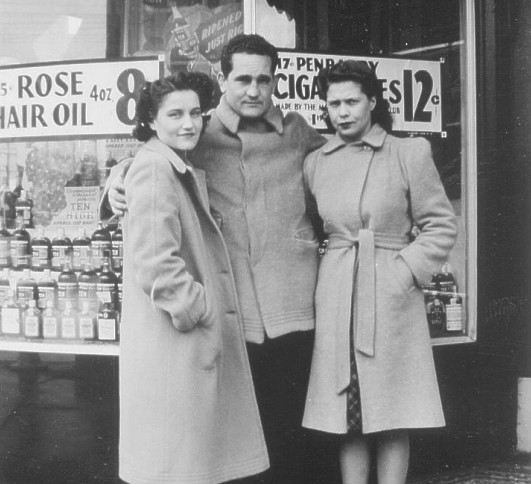Kansas Snapshots by Gloria Freeland - March 19, 2021
No sour Kraut here!
Did you hear the one about the dentist and his beautiful new assistant?
They worked so closely together it eventually led to other things and soon the assistant found she was, as they used to say,
"in a family way." Knowing his wife was suspicious, the dentist suggested she take a trip to a far-off place and he would pay
for her care. She decided Germany sounded interesting, so the dentist told his wife the young woman had decided to spend time
abroad.
Months passed and then one day he received a phone call at home from his lover. He was mortified his wife might overhear and
emphasized the need to be especially careful.
More time passed until when he arrived home one day, his wife told him they had received a postcard from Germany. "What did it
say?" he asked with great trepidation.
"Well it had the strangest message," his wife replied. "All it said was, 'sauerkraut, sauerkraut, sauerkraut: two with wieners
and one without!'"
The news of triplets may have killed any enjoyment the dentist had for the fermented vegetable, but it made me laugh the first
time husband Art told it to me. It still makes me smile when he references it, which he did Saturday when he made pork and
sauerkraut for supper.
I had sauerkraut before I met Art, but it was low on my echelon of food choices - probably because it was served with tepid hot
dogs at our school lunches. But his version has definitely bumped it to my upper tier of meal options.
While Art's last name arises from his one-eighth Welsh heritage, his mother was 100 percent German, so the fact that Donna made
pork and sauerkraut may well seem fitting. But the recipe she handed down to Art didn't come from her mother, but from her sister
Ione.
In the late 1930s, Ione was handling the cosmetics counter in a Ford Hopkins drugstore in Green Bay, Wisconsin. Being from out
of town, she quickly became friends with another employee, who was from Upper Michigan. The store was near the Packers'
headquarters, and players often came into the store to eat at the grill. Bernice eventually married Pete Tinsley, one of the
guards on the team, and Ione was a witness at their wedding. The three spent much time together, and it was Bernice who introduced
Ione to her version of the dish Art makes today. I referenced this in my Aug. 30, 2013 column, "Cabbage
with a connection."
It would be reasonable to assume Bernice's background was German. That assumption arises because we Americans associate sauerkraut
with Germany. While the average American consumes 1.5 pounds of the vegetable per year, Germans eat about 2.6 pounds. Although
the Germans outdo us, the French chow down about twice what the Germans do. Bernice's family traces its roots back to the French
Canadians.
In reality, this fermented delicacy can be found all over Europe. So where did it begin? It can actually be traced back to China,
brought to the West by traders.
Sauerkraut may not be as popular in the U.S. as it is in Germany, but it certainly encouraged America's acceptance of another
German food. While the etymology is a bit murky, Germans had long eaten a small sausage topped with sauerkraut in bread or on a
bun. The small sausage was affectionately known as a "dachshund" - which literally means a badger, but loosely means a small dog.
The sale of these by German vendors in New York and at the 1893 Chicago World's Fair propelled these hot "little dogs" to become
today's popular hot dog, with or without sauerkraut. It's interesting to note that the other popular American term for the hot
dog is "wiener," which in German literally means "from Vienna," which is also famous for its small sausages.
So what is the recipe which converted me from a take-it-or-leave-it sauerkraut consumer to a lover? Art sweetens it! He layers
the bottom of an electric skillet with thinly-cut pork steaks. Then he takes a large can of sauerkraut and spreads it over the
pork. Next is brown sugar - perhaps a cup in total. No one, including Art, knows the exact amount, as he just adds it until the
taste of the juice is "right." Then, to finish things off, he drizzles a thin lattice-work of dark molasses over the top. That
may amount to three or four tablespoons. He optionally adds the equivalent of a tablespoon or two of salt as well. Then he sets
the temperature control such that it is just very gently boiling with the cover in place.
He typically lets that go on for three to four hours, adding a small amount of water if much boils away. When it is done, the
sauerkraut has been transformed from a pale yellow-green to dark brown, and the pork is also dark and separates easily with
the touch of a fork. Boiled or mashed potatoes are the accompaniment.
Many foods people really like activate all five of our taste sensors. The pork gives the dish the umami - savory - effect. The
fermented sauerkraut provides acid that creates the bitter and sour tastes. The brown sugar, molasses and the starch in the
potatoes provide the sweet taste. The salt rounds out the taste bud stimulation.
Art began his efforts at 4 in the afternoon and we sat down to eat about 8 p.m. After, I announced how much I enjoyed it. Art
grinned and reported, �So I guess you are the opposite of a sour Kraut!�
